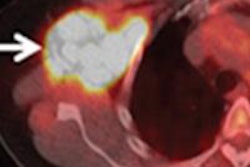Tumor heterogeneity plays a role in response to treatment, which varies between individuals, explained study presenter Dr. Petra Georg, PhD, from the medical department at EBG MedAustron, a center for ion beam therapy and research in Wiener Neustadt, Austria.
"Therefore, it is important to know tumor heterogeneity and its biological characteristics before starting the treatment and their changes during the treatment," Georg wrote in an email to AuntMinnie.com. "The response assessment and its predictive value may help us toward a personalized cancer treatment."
In this study, seven patients were imaged using multiparametric FMISO-PET/MRI for baseline results and then scanned again at two weeks, five weeks, after the start of chemoradiation therapy, and three months post-treatment.
Patients received 330 MBq of FMISO and were scanned using various MRI sequences. While the researchers never found a whole tumor to be FMISO-avid, there were locations within tumors of FMISO avidity indicating hypoxia, which was discovered both before and during the course of therapy.
The discovery of hypoxia by FMISO-PET/MRI becomes an "important predictive factor for treatment resistance and failure," Georg said.
Georg and colleagues plan to expand their research to include other forms of cancer.



















